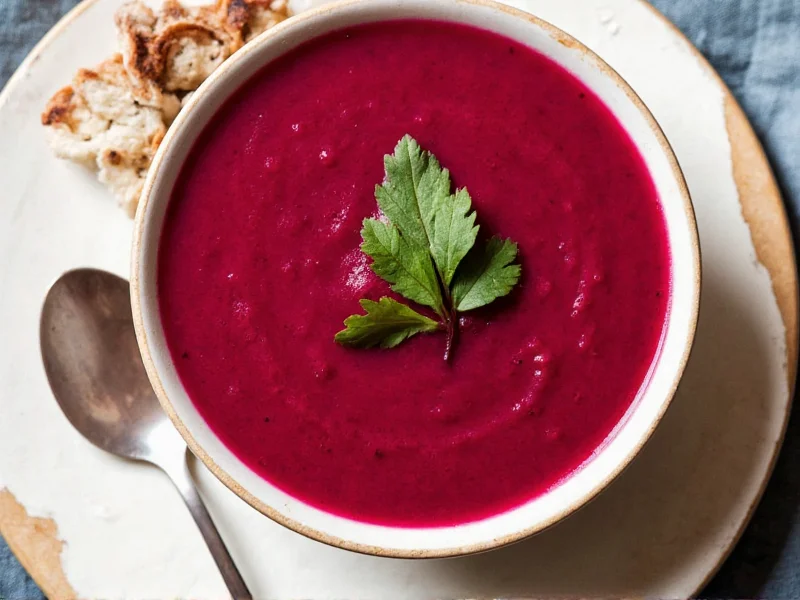For generations, Polish households have perfected the art of crafting this iconic soup, which represents more than just sustenance—it embodies cultural heritage and seasonal traditions. The vibrant crimson color comes from beetroots that have undergone natural fermentation, creating the soup's signature sour profile without vinegar.
The Cultural Significance of Polish Beet Soup
In Poland, barszcz czerwony holds deep cultural importance, particularly during Wigilia (Christmas Eve dinner). Families across Poland begin their festive meal with this clear beet soup, traditionally served with mushroom-filled uszka dumplings. This culinary tradition dates back centuries, with historical records mentioning beet-based soups as early as the 14th century.
The soup's preparation often involves family rituals passed down through generations. Many Polish households still use the traditional method of fermenting beetroots in wooden barrels, though modern adaptations have simplified the process while maintaining authenticity.
Traditional Ingredients and Their Importance
Authentic Polish beet soup requires surprisingly few ingredients, each playing a crucial role in creating its distinctive character:
| Ingredient | Traditional Role | Modern Substitution |
|---|---|---|
| Fresh beetroots | Provides color and earthy sweetness | Pre-cooked beetroots (less ideal) |
| Water | Base liquid for fermentation | None (essential) |
| Sugar | Feeds fermentation process | Honey (alters flavor profile) |
| Lemon juice or vinegar | Alternative acidity (not traditional) | Only for non-fermented versions |
The magic happens through natural fermentation, where sliced beetroots, water, and sugar transform over 3-5 days into a tangy liquid base. This process develops complex flavors that cannot be replicated by simply adding vinegar to beet juice.
Traditional Polish Beet Soup Recipe
Creating authentic barszcz czerwony requires patience but yields extraordinary results. Here's a traditional preparation method:
Ingredients for Traditional Fermented Base
- 1.5 kg fresh beetroots (peeled and thinly sliced)
- 1.5 liters filtered water
- 3 tablespoons sugar
- 1 tablespoon lemon juice (optional, for non-fermented version)
Preparation Steps
- Combine sliced beetroots, water, and sugar in a clean glass jar
- Cover with cheesecloth and secure with rubber band
- Store at room temperature (18-22°C) for 3-5 days
- Strain liquid through cheesecloth into clean container
- Discard solids or use in other recipes
- Store fermented beet broth in refrigerator for up to 3 months
Final Soup Preparation
- Bring 1 liter of the fermented beet broth to gentle simmer
- Add 1 diced onion sautéed in butter until translucent
- Season with salt, white pepper, and optional bay leaf
- Serve hot with uszka dumplings or cold as summer borscht
Regional Variations Across Poland
Polish beet soup varies significantly by region, reflecting local traditions and available ingredients:
- Eastern Poland: Often includes wild mushrooms and forest herbs
- Central Poland: Typically features a stronger fermented flavor profile
- Western Poland: May incorporate apple cider vinegar for quicker preparation
- Mountain regions: Sometimes includes smoked meat broth for heartier version
These regional differences showcase Poland's diverse culinary landscape while maintaining the soup's essential character. The Christmas Eve version remains remarkably consistent nationwide, always featuring the clear beet broth with mushroom-filled uszka.
Polish Beet Soup vs. Russian Borscht
Many confuse Polish barszcz with Russian borscht, but significant differences exist:
- Clarity: Authentic Polish beet soup is clear broth, while borscht typically contains visible vegetables
- Base: Polish version uses fermented beet broth; borscht often uses fresh beets with vinegar
- Meat content: Traditional Polish version is vegetarian; borscht frequently includes meat broth
- Serving temperature: Polish soup served hot or cold; borscht typically hot
- Cultural context: Polish version central to Christmas Eve; borscht serves as everyday meal
Serving Traditions and Accompaniments
How Polish beet soup is served carries cultural significance. During Wigilia, it appears as the first course, always accompanied by uszka ("little ears")—small dumplings filled with wild mushrooms. The soup's vibrant red color symbolizes life and prosperity in Polish tradition.
For everyday consumption, Poles enjoy it with:
- Boiled potatoes
- Fresh rye bread
- Sour cream (śmietana)
- Hard-boiled eggs
During summer months, many Poles serve it chilled as a refreshing starter, sometimes adding chopped fresh dill or chives for additional flavor.
Nutritional Profile of Traditional Polish Beet Soup
Polish beet soup offers notable nutritional benefits when prepared traditionally:
- Rich in betalains (natural pigments with antioxidant properties)
- Contains natural probiotics from fermentation process
- Low in calories (approximately 50-70 calories per serving)
- Provides vitamin C, folate, and potassium
- Naturally gluten-free and vegetarian
The fermentation process enhances digestibility and increases bioavailability of nutrients, making traditional Polish beet soup not only culturally significant but nutritionally valuable.
Common Preparation Mistakes to Avoid
Even experienced cooks can make errors when preparing authentic Polish beet soup:
- Using vinegar instead of proper fermentation (creates artificial sourness)
- Overcooking beetroots (reduces vibrant color and flavor)
- Adding too many vegetables (makes it borscht, not authentic barszcz)
- Using metal containers for fermentation (reacts with acids)
- Serving without traditional accompaniments (misses cultural context)
For the most authentic experience, allow proper fermentation time and maintain the soup's clarity by straining thoroughly before serving.











 浙公网安备
33010002000092号
浙公网安备
33010002000092号 浙B2-20120091-4
浙B2-20120091-4